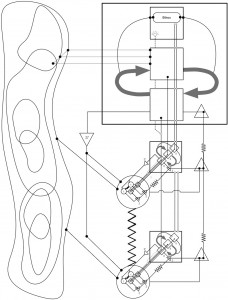I am really exited to attend at the European Meetings on Cybernetics and System Research in Vienna! This is my abstract which will be published in the conference book 🙂
Field of Research: Applications of the Viable System Model
Headline: POSIWID – The Purpose Of a System Is What It Does
Subheadline: The VSM as part of a solution to cope with migration and demographic change
Name: Mark Lambertz, Institute for Acceleration

There are many global challenges that our civilization has to tackle. One important question is how an aging society will be able to sustain its internal stability and combine this with the enormous challenge of planetary migration trends.
The session will not only introduce the Viable System Model, but also extrapolate pragmatic strategic advices on how to handle related issues like the integration of migrating people.
The Viable System Model from Stafford Beer (Management and Cybernetics, 1959) is part of the discipline of Management Cybernetics and basically describes how a viable system is structured and which insights can be deducted in order to plan, implement and operate an efficient organization. It could be seen as the metaplan for an information network which ensures the ability to optimize the “inside and now” and integrate the demands of “outside and later”. The aspect of viability and its isomorphic character offer provoking thoughts for the traditional governance (management) and its approach to cope with complexity.
The model claims are strong:
- Strengthening the internal cohesive forces (resilience)
- Ability to adapt itself within non-linear environments (innovation)
- Enhancement of the total agility of an organization (speed)
- Provide meaning for every part of the system, thereby the true potential unfolds itself (intrinsic motivation)
The model explains how responsibility should be handled, how regulation between operation and governance must be designed and how autonomy and hierarchy must be balanced in order to fulfil the designated purpose of a system.
Further more the session will cover the basic concept of control in terms of Ashbys Law of Requisite Variety, which could be understood as Newtons Gravitational Laws of Cybernetics. In this context Variety is meant to be the measure of possible states of a system. Without a fundamental understanding of the concept of control by absorbing variety, it is very difficult to develop a normative, strategic and tactical framework for the addressed topics.
It is also very important to understand the Principles of Management in order to identify and design the system components and its relations with its operational neighbours. Only then each “part of a greater whole” can identify its natural tasks and start to operate as a service function for the other members of the organization. Basically this implies the insight, that the “machine room of migration and demographic change” must be equipped with the requisite resources and rules, thereby the needed Requisite Variety level can be achieved.
Besides the partially abstract Principles of Management the model offers a unique visualization of structure and processes within a viable system. Especially for visually oriented people the schematics of the VSM are a very good tool to understand the dynamics and interconnections of complex organizations which have to deal with complex environments. It makes it clear, why every viable system needs the collective intelligence of all members of the system and what responsibility actually means.
Of course the VSM is just a tool, which is more or less useful, and the model alone can not (dis)solve all problems within the special focus on demographic change and migration issues. But it offers diagnostic insights which help to identify practical options for action, so that the system can efficiently pursue its purpose and deliver the desired results.

